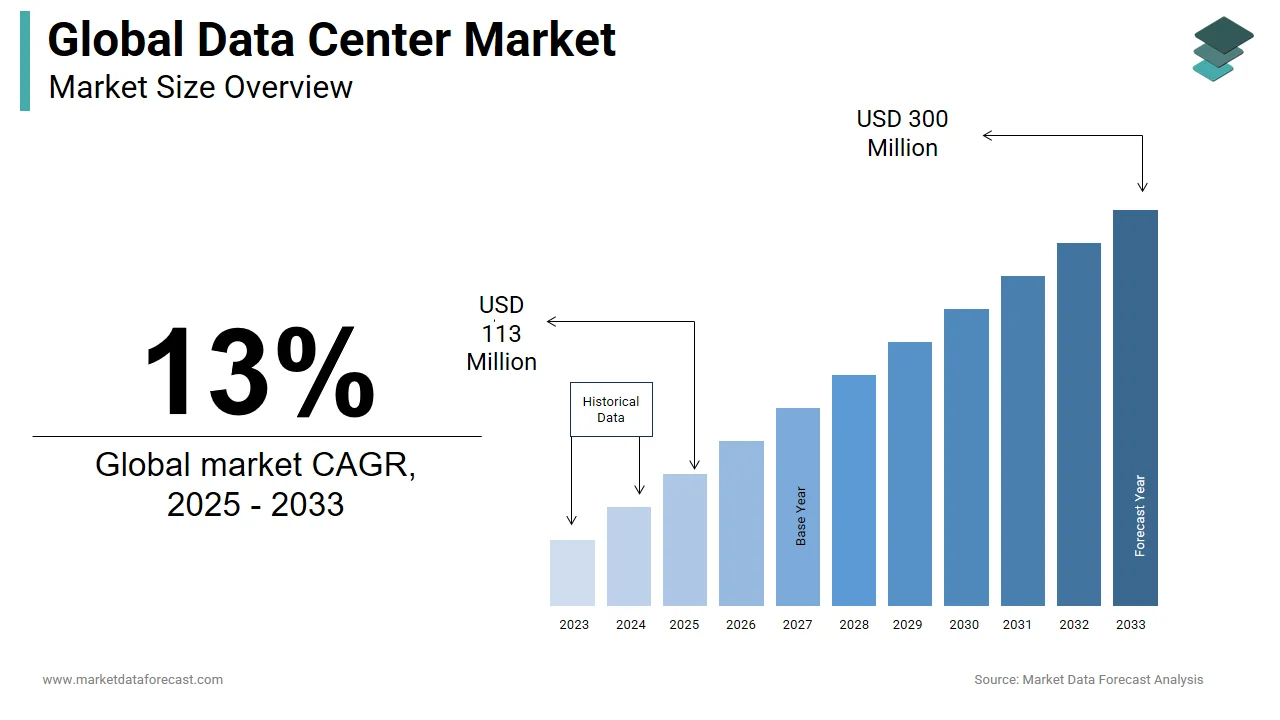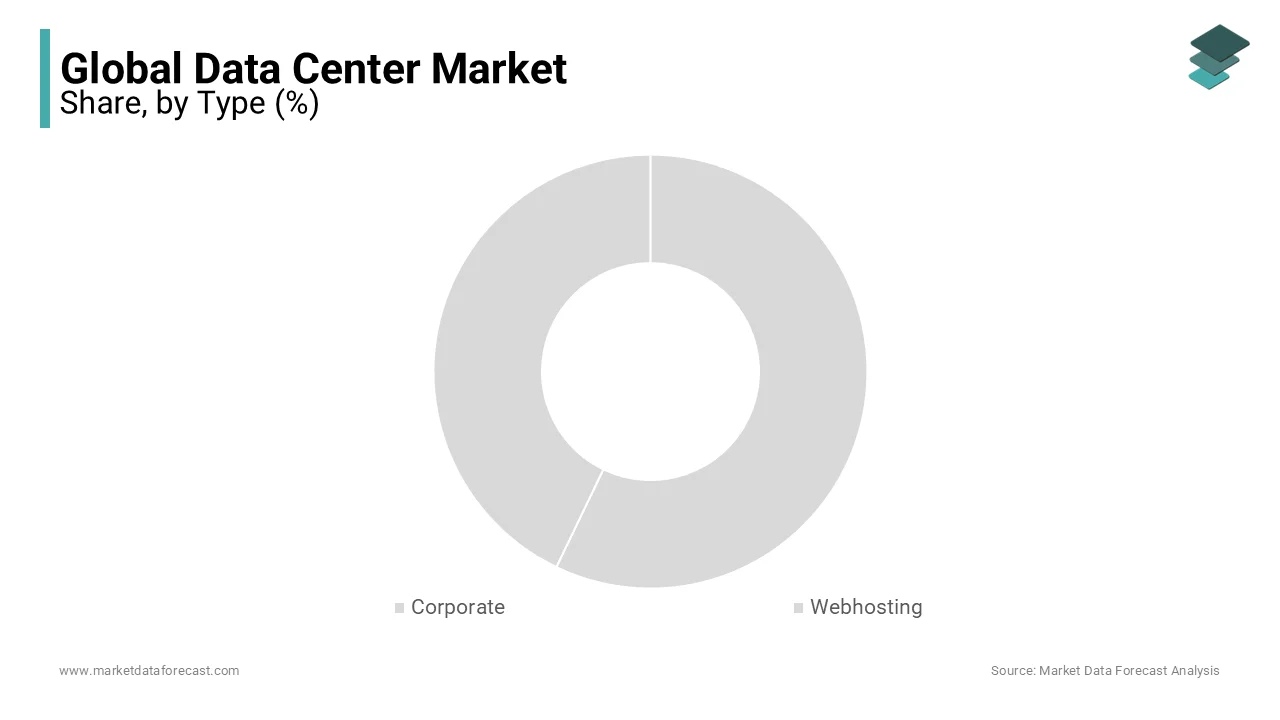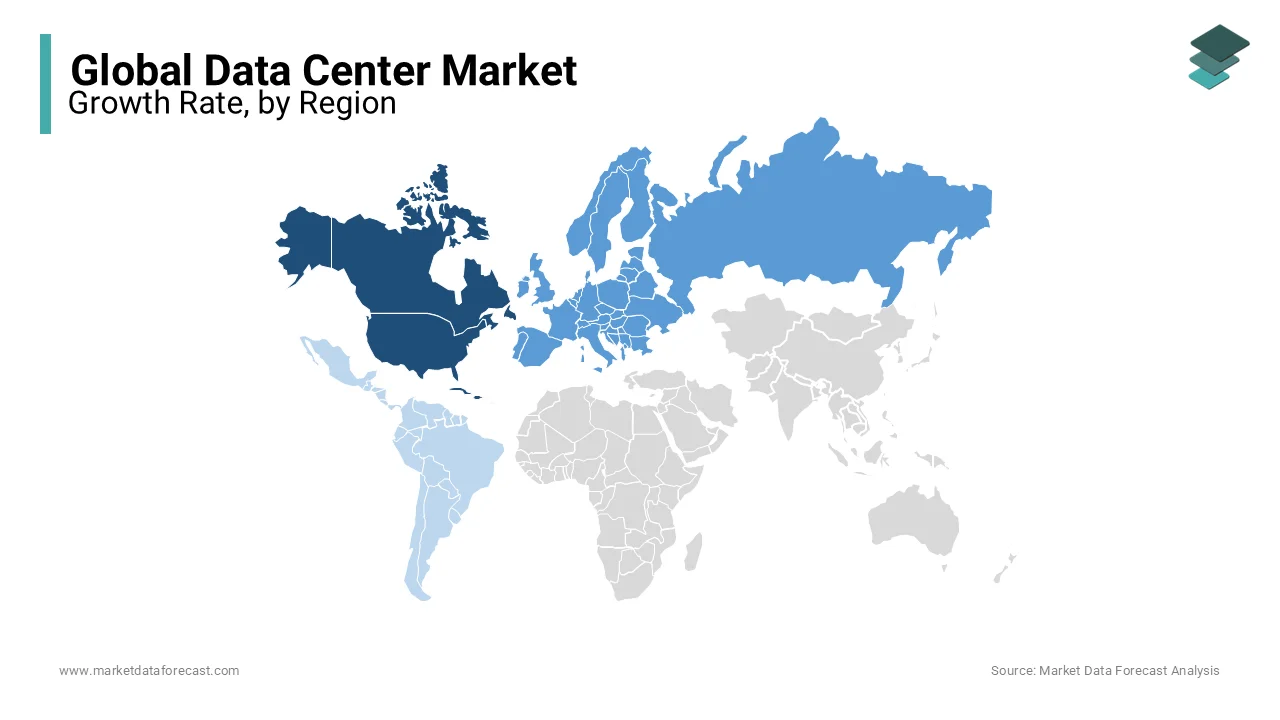Global Data Center Market Size, Share, Trends, & Growth Forecast Report by Type (Corporate, Webhosting), Destiny (Low, Medium, High, Extreme), Industry (Banking and financial services, Telecom and IT, Government, Healthcare), & Region - Industry Forecast From 2025 to 2033
Global Data Center Market Size
The global data center market size was worth USD 100 million in 2024. The global market is predicted to reach USD 113 million in 2025 and is anticipated to reach a valuation of USD 300 million by 2033 with a CAGR of 13% during the forecast period.

A data center is like a giant hub that stores and manages vast amounts of information for different purposes. It's a specialized building filled with powerful computers, storage systems, and networking gear that work together to handle and process data. From storing files and running websites to supporting online services and business operations, data centers are the backbone of digital activities. They're equipped with security measures and technologies to keep data safe and running smoothly, playing a crucial role in today's interconnected world by ensuring information is accessible and secure.
MARKET DRIVERS
The Data Center market is experiencing a robust surge, propelled by the escalating demand for cloud services among businesses.
The pervasive adoption of cloud computing for storage, processing, and application hosting is a pivotal driver, necessitating expansive data center infrastructure to underpin the operations of cloud service providers. This surge in reliance on cloud services mirrors a broader trend of digital transformation across industries, heightening the need for scalable and resilient data center solutions. This intricate connection between cloud services and data center infrastructure underscores the pivotal role of data centers in enabling the seamless and efficient delivery of contemporary digital services worldwide.
MARKET RESTRAINTS
High cost is a significant restraint in the Data Center market, acting as a deterrent, particularly for smaller businesses with constrained budgets.
The establishment and maintenance of a data center demand substantial upfront investments encompassing essential infrastructure components such as servers, networking equipment, and cooling systems. This financial barrier inhibits the entry and expansion of smaller enterprises into the data center arena, limiting their ability to harness the advantages of robust digital infrastructure. As the demand for data processing and storage continues to escalate, addressing these cost challenges becomes paramount.
REPORT COVERAGE
|
REPORT METRIC |
DETAILS |
|
Market Size Available |
2024 to 2033 |
|
Base Year |
2024 |
|
Forecast Period |
2025 to 2033 |
|
CAGR |
13% |
|
Segments Covered |
By Type, Density, Industry, and Region |
|
Various Analyses Covered |
Global, Regional & Country Level Analysis, Segment-Level Analysis, DROC, PESTLE Analysis, Porter’s Five Forces Analysis, Competitive Landscape, Analyst Overview on Investment Opportunities |
|
Regions Covered |
North America, Europe, APAC, Latin America, Middle East & Africa |
|
Market Leaders Profiled |
Equinix, Digital Realty, NTT Communications, CyrusOne, Global Switch, Interxion (now part of Digital Realty), CoreSite Realty Corporation, QTS Realty Trust, Iron Mountain Data Centers, Cyxtera Technologies, and Others. |
SEGMENTAL ANALYSIS
By Type Insights

Corporate data centers hold the largest market share as these facilities support critical business applications, data storage, and internal communication systems. They are often characterized by a focus on security, reliability, and the seamless functioning of internal processes. Corporate data centers are essential for large enterprises managing their IT infrastructure in-house, ensuring data security and compliance with industry regulations. While they may not be as visible as web hosting data centers, they play a vital role in supporting the core operations of businesses.
Web hosting services represent a substantial growth rate in the data center market, prioritizing scalability, high availability, and efficient content distribution. Amid the ascent of cloud computing and the escalating dependence on online services, web-hosting data centers have experienced remarkable market expansion. Catering to a diverse clientele, from small enterprises to large corporations, these centers furnish solutions enabling robust online establishments and play a crucial role in sustaining organizations' online presence and operations.
By Density Insights
High-density data centers are dominating the market growth. This is achieved through advanced cooling technologies and optimized infrastructure. High-density centers are well-suited for applications with demanding computational requirements, such as AI, machine learning, and big data analytics. Their efficiency and space utilization contribute to their growing prevalence.
Low-density data centers hold the second largest market share and have a lower concentration of IT equipment per square foot. These facilities are characterized by a more traditional and spread-out infrastructure, often suitable for basic computing needs.
Medium-density data centers strike a balance between computing power and resource efficiency. They offer a moderate concentration of IT equipment and are suitable for a range of applications. Medium-density facilities provide a compromise between the cost-effectiveness of low-density and the performance capabilities of high-density centers.
By Industry Insights
The banking and financial services industry plays a dominating role in market growth as this sector handles extensive financial transactions, manages large datasets, and complies with stringent regulatory standards. The dominance of data centers in banking and finance is driven by the need for robust infrastructure to ensure the confidentiality and integrity of sensitive financial information. The dominance is further fueled by the increasing adoption of fintech solutions, digital banking, and the growing volume of online financial transactions.
Government agencies hold the second largest market share, which includes data storage, processing citizen information, and hosting critical applications. Government data centers often prioritize security, compliance, and disaster recovery capabilities. The dominance is driven by the need for secure and compliant infrastructure for government operations, including defense, healthcare, and public services.
The healthcare industry relies on data centers to manage electronic health records, medical imaging data, and support healthcare applications. The dominance of data centers in healthcare is increasing as the industry undergoes digital transformation. The growing use of telemedicine, electronic health records, and data-intensive medical research drives the demand for robust and secure data center infrastructure.
REGIONAL ANALYSIS

North America dominates the data center market. The region, especially the United States, boasts a mature and sophisticated market driven by tech giants, cloud services, and the evolving needs of various industries. Its dominance stems from extensive IT infrastructure, innovation hubs, and a robust digital economy.
Europe is following North America in leading the market size, driven by countries like the UK, Germany, and the Netherlands. The region's strength lies in its progressive approach toward data privacy regulations, sustainability initiatives, and investments in renewable energy, which shapes the demand for advanced data center infrastructure.
The Asia-Pacific Data Center Market is expected to grow at the highest CAGR by the end of 2028 due to expanding digitalization efforts in countries like China, India, and Singapore. Rapid urbanization, burgeoning internet penetration, and growing cloud adoption are fueling demand. The region's dominance is bolstered by the emergence of tech hubs and substantial investments in data center infrastructure.
The Middle East and Africa have a smaller yet growing share in the Data Center Market. Countries like the UAE are investing in digital transformation, encouraging data center development, and supporting a burgeoning tech ecosystem in the region.
Latin America has a developing Data Center Market. Countries like Brazil and Mexico are witnessing growth, driven by increasing internet penetration and the adoption of cloud-based services, though the market is relatively smaller compared to other regions.
KEY MARKET PLAYERS
Equinix, Digital Realty, NTT Communications, CyrusOne, Global Switch, Interxion (now part of Digital Realty), CoreSite Realty Corporation, QTS Realty Trust, Iron Mountain Data Centers, Cyxtera Technologies, and Others.
MARKET SEGMENTATION
This research report on the global data center market has been segmented and sub-segmented based on the type, density, industry, and region.
By Type
- Corporate
- Webhosting
By density
- Low
- Medium
- High
- Extreme
By industry
- Banking and financial services
- Telecom and IT
- Government
- Healthcare
By Region
- North America
- Europe
- Asia-Pacific
- Latin America
- The Middle East and Africa
Frequently Asked Questions
What factors are driving the growth of the data center market in emerging economies?
Emerging economies are experiencing rapid growth in the data center market due to factors such as increasing internet penetration, rising adoption of cloud services, digital transformation initiatives by governments, and the proliferation of IoT devices. Additionally, the need for robust infrastructure to support e-commerce, online banking, and other digital services is fueling demand for data centers in these regions.
How are regulations and compliance requirements impacting the global data center market?
Regulations and compliance requirements related to data privacy, security, and environmental sustainability vary across different regions and countries, significantly impacting the design, construction, and operation of data centers. Compliance with regulations such as GDPR in Europe and CCPA in California is driving investments in data security and privacy measures, while environmental regulations are pushing for more energy-efficient and eco-friendly data center designs.
How is the adoption of artificial intelligence (AI) impacting the global data center market?
The adoption of AI is driving demand for more powerful and specialized hardware accelerators such as GPUs and TPUs, leading to the development of AI-optimized data center architectures. AI is also being used to enhance data center operations through predictive maintenance, anomaly detection, and optimization of resource utilization, improving efficiency and reducing downtime.
What are the emerging trends in data center networking and connectivity on a global scale?
Emerging trends in data center networking include the adoption of technologies such as software-defined networking (SDN) and network function virtualization (NFV) to improve agility, scalability, and automation. Additionally, there is a growing focus on high-speed interconnects like 400G Ethernet and optical networking solutions to meet the increasing bandwidth requirements of modern applications and workloads.
Related Reports
Access the study in MULTIPLE FORMATS
Purchase options starting from
$ 2500
Didn’t find what you’re looking for?
TALK TO OUR ANALYST TEAM
Need something within your budget?
NO WORRIES! WE GOT YOU COVERED!
Call us on: +1 888 702 9696 (U.S Toll Free)
Write to us: sales@marketdataforecast.com